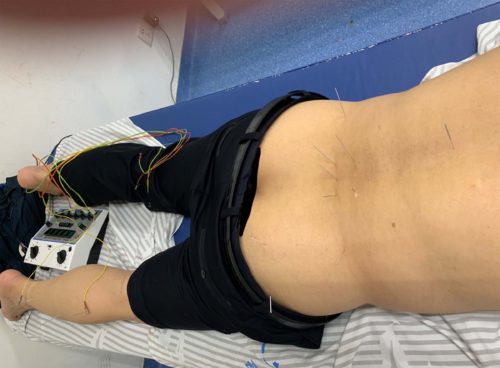When it comes to getting pregnant, old-world techniques may be just what today’s high-tech doctors will order.
By: John Lally Lic.AC.TCM, Clin.AC, Clinic Director

A patient receiving electro acupuncture for back pain
Chronic Back Pain is one of the most common reasons people seek medical attention. It has been estimated that up to 80% of the world’s population will suffer from back pain at some point in their lives, with the lower back as the most common location of the pain.
Lumbar Muscle Strain
Muscle strains are the most common cause of low back pain. Patients may or may not remember the initial event that triggered their muscle spasm, but the good news is that most episodes of back pain from muscle strains resolve completely within a few weeks.
Ruptured Disc
A ruptured intervertebral disc also called a herniated disc, is another common cause of back pain. How to treat the back pain from a herniated disc depends on the particular individual and situation.
Discogenic Back Pain
Discogenic back pain is thought to be a common cause of low back pain. Discogenic back pain is the result of damage to the intervertebral disc but without disc herniation. Diagnosis of discogenic back pain may require the use of a discogram.
Spinal Stenosis
Spinal stenosis causes back pain in the aging population. As we age, the spinal canal can become constricted, due in part to arthritis and other conditions. If the spinal canal becomes too tight, back pain can be the result.
Lumbar Spine Arthritis
Arthritis most commonly affects joints such as the knees and fingers. However, arthritis can affect any joint in the body, including the small joints of the spine. Arthritis of the spine can cause back pain with movement.
Spondylolisthesis
Spondylolisthesis causes back pain because the adjacent vertebra becomes unstable and begins to “slip.” The most common cause of spondylolisthesis is due to degenerative changes causing loss of the normal stabilizing structures of the spinal column. If the spine becomes unstable enough, back pain can become a problem.
About the Author: John Lally Lic.AC.TCM, Clin.AC is the clinic director at the Blue Heron Acupuncture Clinic in Galway, Ireland and is a member of the Acupuncture Foundation Professional Association of Ireland and the European Traditional Chinese Medicine Association (ETMCA)
References:
1- By John Lally Lic.AC.TCM, Clin.AC, The Blue Heron Acupuncture Clinic in Galway, Ireland